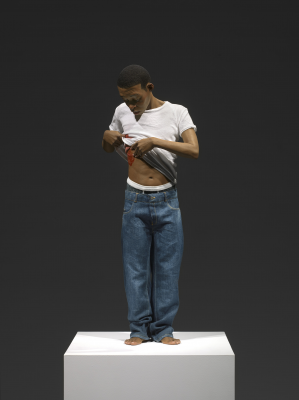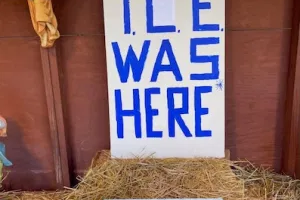National Gallery: Sin

Image: Ron Mueck, 'Youth', 2009. Courtesy the artist © Ron Mueck / photo the National Gallery, London
The first exhibition in the UK exploring sin in art will be staged at the National Gallery this autumn.
Sin will bring together paintings from the National Gallery's collection dating from the 16th to the 18th century with loans from important private and public collections including modern and contemporary works by Andy Warhol, Tracey Emin, and Ron Mueck. There will be 14 works on display.
Sin has been a recurrent subject for artistic exploration over the centuries across the world. Sin in a religious context means an immoral act that is considered to be a transgression against divine law. In a secular world, it means a serious or regrettable fault, offence or omission. Sin is as universal as it is personal. Most people at some point in their life will do something they regret, although the gravity of their 'sin' and the way each individual or society deals with it very much depends on the country, time and socio-cultural context. While the concerns, ambiguities, perceptions and representations of sin extend across world religions and to those of no faith, Sin will primarily explore this concept within a Christian context.
Two early paintings in the exhibition, The Garden of Eden by Jan Brueghel the Elder, 1613 (on loan from a private collection, Hong Kong) and Adam and Eve by Lucas Cranach the Elder, 1526 (on loan from The Samuel Courtauld Trust, The Courtauld Gallery, London) feature scenes from the Old Testament which have helped define the concept of sin in the collective 'Western' consciousness: the moment described in the Book of Genesis when Adam and Eve eat the forbidden fruit from the tree of knowledge and are subsequently expelled from the Garden of Eden for committing the first sin.
Both pictures are ambiguous as they tell and warn the viewer about sin and yet portray the naked body as seductive and a potential source of temptation.
Many artists over the centuries have sought to depict the seven deadly sins (pride, greed, lust, envy, gluttony, wrath and sloth), the group of sins defined as the worst by the sixth-century pope, Gregory I (Saint Gregory the Great).
The 18th-century British painter William Hogarth was a master at depicting sinful behaviour. In his Marriage A-la-Mode series, and in particular in The Tête à Tête, about 1743 (the National Gallery, London), he shows a young 'couple of convenience', sprawled slothfully in their Palladian London townhouse. The wife has tea for one, an indication of the separate life she leads from her husband. The husband, meanwhile, does not even try to hide his mistress's cap as it falls out of his pocket, attracting the attention of his curious dog. A large black spot on his neck denotes he has caught syphilis, presumably from his mistress.
While many paintings depict sinful behaviour, some portray people who are regarded as being without sin, notably the Virgin Mary, whom Christians recognise as the mother of God's son, Jesus. Her purity is equated with her beauty in Diego Velázquez's Immaculate Conception, 1618-19 (the National Gallery, London).
Other paintings show acts of redemption, atonement and confession: the options available to cancel out sin. Few artists have addressed repentance as directly as Andy Warhol did in some of his last paintings, such as Repent, and Sin No More!, 1985-6 (ARTIST ROOMS: Tate and National Galleries of Scotland) based on a leaflet distributed in the streets of New York.
Some works in the exhibition shed light on the power of confession, either to free oneself from the burden of sin or to obtain forgiveness. The Mass of Saint Giles, about 1500 (the National Gallery, London) shows the Holy Roman Emperor Charlemagne kneeling in front of Saint Giles, whose prayers of intercession to God led to the absolution of the Emperor from his sins. Tracey Emin's neon work It was just a kiss, 2010 (Exhibition Copy, Courtesy of the Artist and White Cube) could be considered an open-ended and ambiguous secular confession.
A painting entitled The Scapegoat by William Holman Hunt (1854-5, Manchester Art Gallery) explores another solution to get rid of sin. The origin of the theme is found in the Old Testament Book of Leviticus, and the term is also used for the idea of blaming someone for the faults of others. Christians believe that Christ's death on the cross, as the ultimate scapegoat, atoned for humankind's sins once and for all.
Youth, 2009 (Courtesy the artist) a sculpture by Ron Mueck, invites us, on leaving the exhibition, to continue to reflect on the enduring nature of sin and on what sin and redemption mean in contemporary society. A young man lifts his T-shirt to examine a wound. It evokes the image of Christ showing his sacrificial wound. Is Youth another type of Christ? The work proposes a path of redemption that questions, disrupts and dismantles stereotypes and prejudices perpetuated by society's ongoing cycle of sin.
Sin will also include paintings by Jan Gossaert, Jan Steen, Bronzino, and the Gallery's recently acquired Venus and Cupid (1529) by Lucas Cranach the Elder.
Dr Joost Joustra, Howard and Roberta Ahmanson Research Curator, says: 'Sin invites visitors to reflect on a fundamental concept that pervades our lives and history, but also to marvel at the ingenious ways artists have addressed the subject across time.'
Dr Gabriele Finaldi, Director of the National Gallery, said: "Sin is a deadly serious subject and artists over the centuries have treated it with imagination and inventiveness. This small exhibition packs a big punch and will, I hope, lead to much discussion and reflection on the meaning and imagery of sin."
Sin runs from 7 October 2020 - 3 January 2021 in the Ground Floor Galleries. Admission free.
For more information, visit: www.nationalgallery.org.uk


















